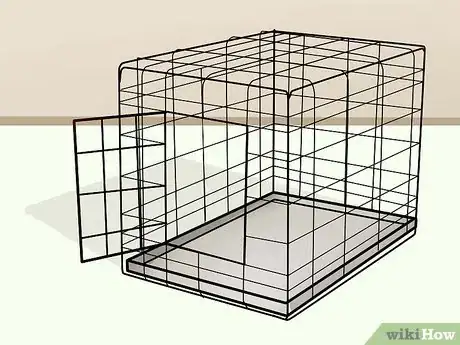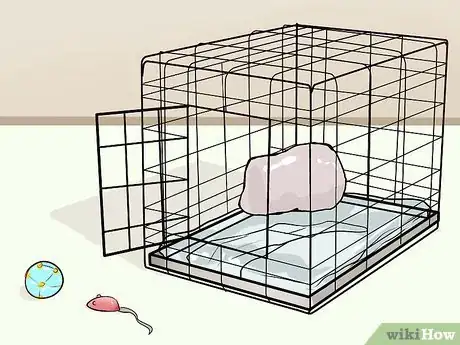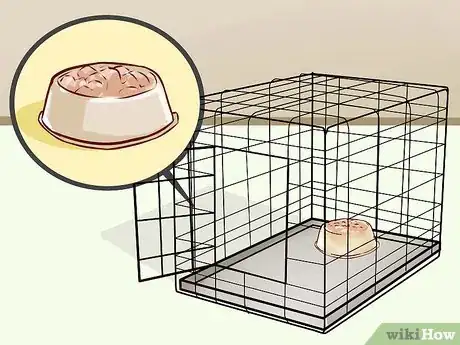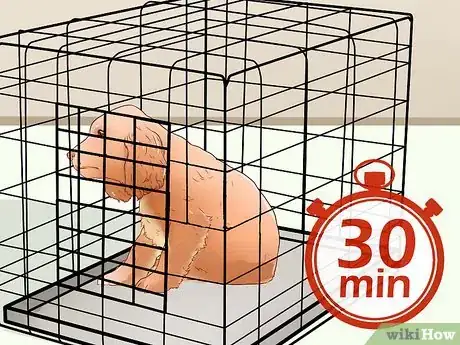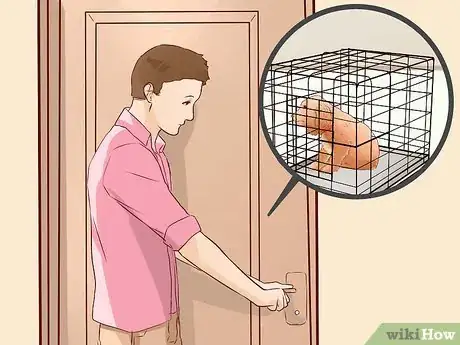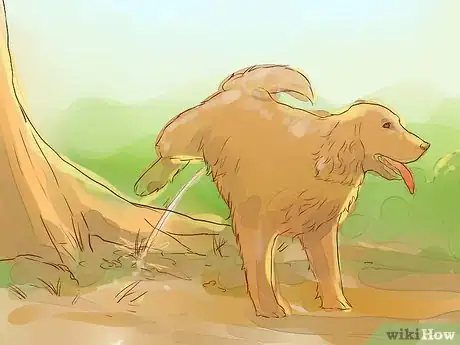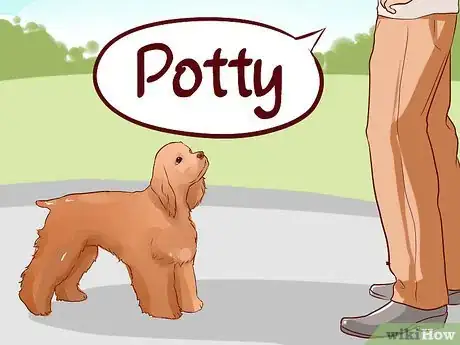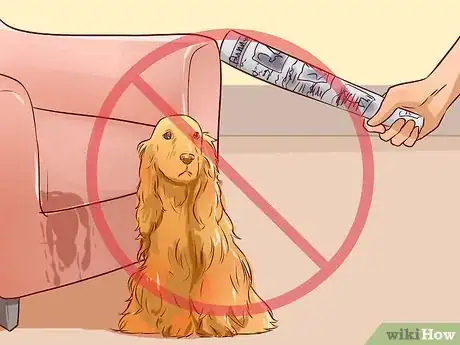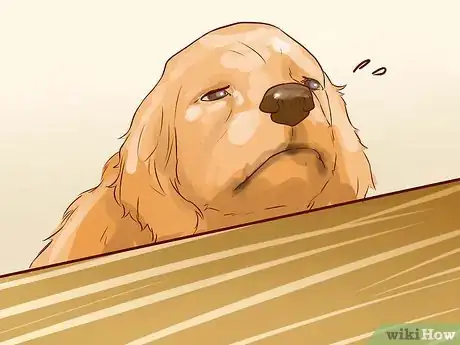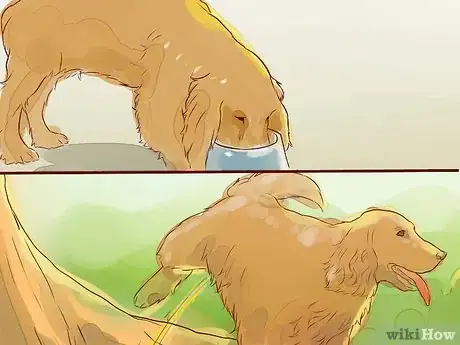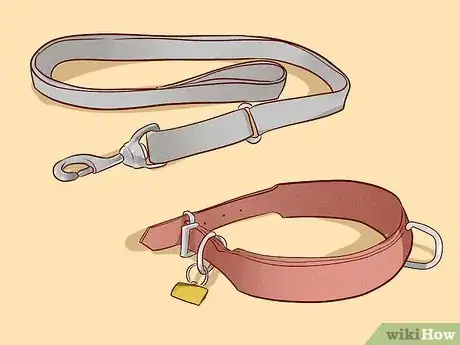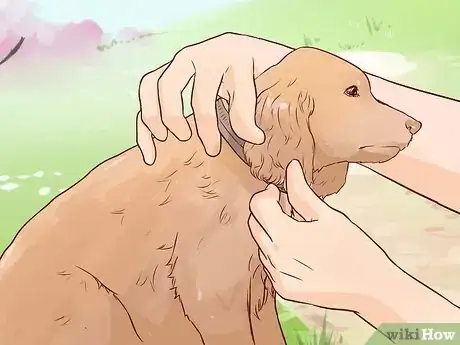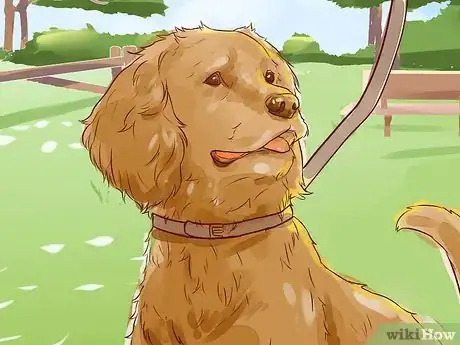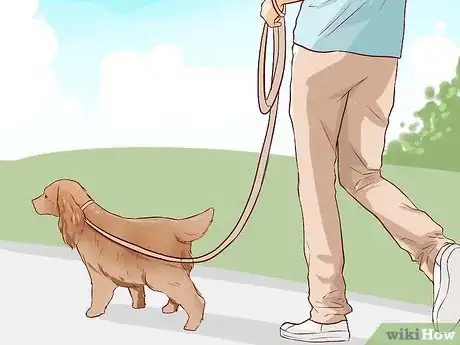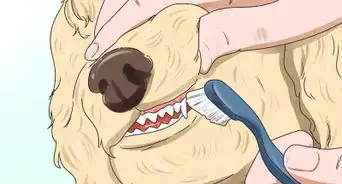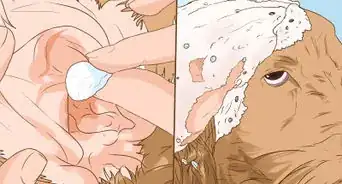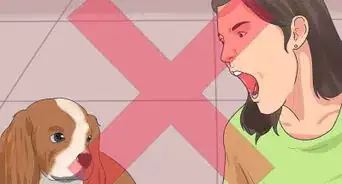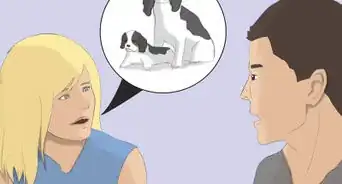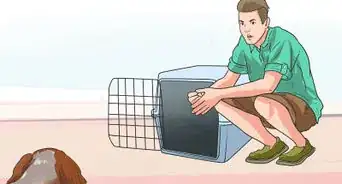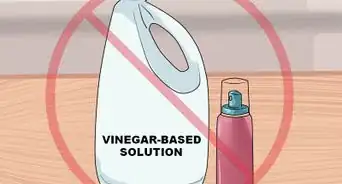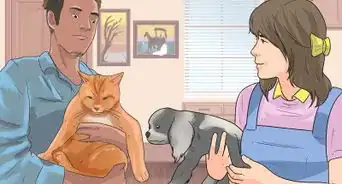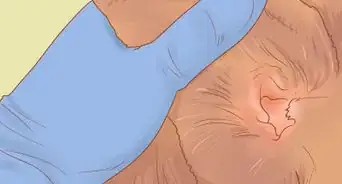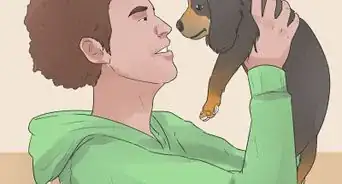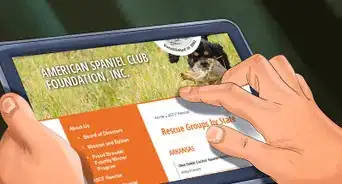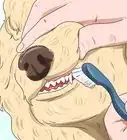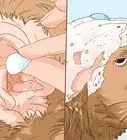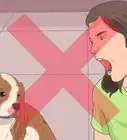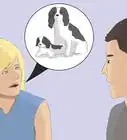This article was co-authored by Brian Bourquin, DVM. Brian Bourquin, better known as “Dr. B” to his clients, is a Veterinarian and the Owner of Boston Veterinary Clinic, a pet health care and veterinary clinic with three locations, South End/Bay Village, the Seaport, and Brookline, Massachusetts. Boston Veterinary Clinic specializes in primary veterinary care, including wellness and preventative care, sick and emergency care, soft-tissue surgery, dentistry. The clinic also provides specialty services in behavior, nutrition, and alternative pain management therapies using acupuncture, and therapeutic laser treatments. Boston Veterinary Clinic is an AAHA (American Animal Hospital Association) accredited hospital and Boston’s first Fear Free Certified Clinic. Brian has over 19 years of veterinary experience and earned his Doctor of Veterinary Medicine from Cornell University.
There are 11 references cited in this article, which can be found at the bottom of the page.
wikiHow marks an article as reader-approved once it receives enough positive feedback. In this case, 94% of readers who voted found the article helpful, earning it our reader-approved status.
This article has been viewed 157,925 times.
Cocker spaniels are easygoing, cheerful, and playful dogs that make excellent pets.[1] Fortunately, cocker spaniels are very easy to train, especially when they are trained as puppies. Training your cocker spaniel will require plenty of repetition, patience, and positive reinforcement. In time, he will become a well-trained and well-behaved pet.
Steps
Crate Training Your Cocker Spaniel
-
1Select a crate for your cocker spaniel. An important aspect of training your cocker spaniel is crate training. When done properly, your dog will see his crate as a place of refuge and relaxation, rather than a place of punishment.[2] Crates, which are available at your local pet store, come in different sizes and materials , such as plastic, fabric, and metal.[3]
- If your dog is a puppy, consider renting a crate from your local animal shelter, since he will eventually outgrow it. This will keep you from having to purchase new crates as he continues to grow.[4]
- Your dog should be able to fit comfortably inside the crate, with enough room to stand up and turn around.[5] Take your dog with you when you look at crates so that you will know what size and type will work for him.
-
2Make the crate comfortable for your dog. The more inviting the crate looks to your dog, the more likely he will want to spend time inside of it. Position the crate in a common area in your house, such as the family room, and place comfortable bedding inside of it. You can also play some of his toys in the crate, along with some treats.[6] [7]Advertisement
-
3Feed your dog his meals in his crate. When it is time to feed your cocker spaniel, place his food bowl in the crate. Place the food bowl near the back of the crate so that he will need to walk completely into the crate to eat.[10] If he is not comfortable with walking all the way to the back, move his food bowl closer to the front of the crate where he will be more comfortable.[11]
- As he becomes more comfortable, you can slide the food bowl further and further back inside the crate.[12] Eventually, he should be able to walk all the way into the crate to eat his meals.
- When he is fully inside the crate to eat, close the crate’s door. Initially, leave it closed only for the amount of time that it takes him to eat. As his comfort level increases, leave the door closed for up to about 10 minutes after he has finished eating.[13]
- If he whines to be let out during this process, wait until he stops whining to open the door. If you open the door while he is whining, he will learn that whining is a way to be let out of the crate.[14]
-
4Crate your dog for up to 30 minutes. After your cocker spaniel is comfortable eating in his crate, he will need to learn how to be comfortable in his crate for longer periods of time (30 minutes or more). First, encourage him to go into his crate by pointing to his crate and saying “kennel.” When he goes inside, give him a treat as a reward and close the door. Stay near the crate for about 5 to 10 minutes, and then go to another room where he can’t see you for a few minutes. When you come back, stay near the crate again for a few minutes and then let him out.[15]
- Remember not to let him out if he starts whining.
- Reward him when you let him out to let him know that he did a good job.
- Your dog may need up to several weeks to become comfortable with staying in his crate for 30 minutes, especially when he can’t see you.[16]
-
5Crate your dog when you leave home.[17] Before you leave your house, encourage your dog to enter his crate as before. When he is in his crate, reward with him a treat, close the crate door, and leave quietly. It is important not to prolong your departure or make it overly emotional. When you return home, stay calm when you approach his crate to let him out.[18]
- The more calm that you are when you leave and return, the more likely your dog will remain calm as well. You do not want him to interpret your departure and arrival as anxiety-inducing events.[19]
- Begin by leaving the house for short periods of time (20 to 30 minutes). As your dog becomes more comfortable with being left alone in the crate, you can try leaving home for longer periods of time.
- Continue to crate him while you are at home so that he does not automatically associate crate time with being left alone.[20]
Potty Training Your Cocker Spaniel
-
1Choose an outdoor spot for your dog to go to the bathroom. Potty training can actually go hand-in-hand with crate training, since your dog will not want to relieve himself in the area where he stays inside the house. When you take him outside on the leash, give him some freedom to choose the area where he wants to go. Keep in mind that he may choose somewhere other than grass, such as soil or mulch.[21]
- Guide him away from areas that would not be appropriate, such as your neighbor’s yard or your plants.
- If you have your own fenced-in backyard, it may not be necessary to take him out on the leash to select a spot. He will know that the backyard is where he is supposed to go to the bathroom.
- Whichever spot he chooses, take him to this spot each time that you take him outside on the leash to go to the bathroom.
-
2Give him the “potty” command. When you are at the designated bathroom spot, say “potty” and wait for him to go. This may take several minutes, since he may not understand this verbal command right away. After he goes to the bathroom, reward him with a treat.[22]
- If he does not go to the bathroom after several minutes, take him back inside and wait for about 15 minutes. If you had him on a leash, keep his leash on him during this 15-minute wait period. Then, take him back outside again to the same spot. Repeat this until he goes to the bathroom outside. Once he goes, reward him with a treat.[23]
- Make sure that he does not go to the bathroom inside during the wait period.[24] This may be more likely to happen if your cocker spaniel is a puppy.
- It may take a lot of repetition before your dog knows that he should go to the bathroom in the same spot outside.
-
3Do not punish him if he goes to the bathroom inside. Cocker spaniels are very sensitive to punishment,[25] so do not verbally or physically punish him if he goes to the bathroom inside. If you see him in the act of going to the bathroom inside, try to interrupt him and get his attention by clapping loudly with your hands. Take him outside to the designated bathroom spot as quickly as possible, either by picking him up and carrying him or walking him on the leash.[26]
- When you get back inside, clean up the mess without punishing him.[27]
- Your cocker spaniel may relieve himself inside because of a medical issue, [28] such as kidney disease. If he is consistently going to the bathroom inside your house despite potty training, take him to your veterinarian so that he can be examined for underlying medical conditions.
-
4Recognize when your dog needs to go the bathroom. More than likely, your cocker spaniel will let you know when he needs to relieve himself. When he is inside, he may start whining or whimpering to let you know that he needs to go outside. Take him out as soon as you can if he starts doing this. If you are outside on a walk, he may start circling or sniffing places to find the perfect spot to go.[29]
- If you are out on a long walk, keep in mind that it may not be practical to make it back to his regular bathroom spot in time. If this is the case, allow him to go the bathroom where you are and pick up his waste if necessary.
-
5Feed your dog and take him out on a regular schedule. Feeding him on a regular schedule will likely lead to him needing to go to the bathroom at around the same time each day. Cocker spaniels have small bladders, so you may need to take him out several times a day (about every four to five hours) so that he can relieve himself. If your schedule does not allow for you to take your dog out this frequently, consider having a dog walker take your dog out when you are not home.[30]
Leash Training Your Cocker Spaniel
-
1Choose a leash and collar for your dog. If you have not already selected a leash and collar your cocker spaniel, you can purchase them at your local pet store. The leash should be either four or six feet in length. A regular snap or buckle collar will be suitable. Body harnesses, choke collars, and pinch collars are not suitable for training your cocker spaniel to walk on a leash.[31]
- Make sure that the leash is non-retractable. Retractable leashes can actually encourage your dog to pull and not walk beside you.
-
2Familiarize your cocker spaniel with his collar. This is important if your cocker spaniel is a puppy and is not used to having anything on his neck. This step will probably not be necessary for an adult cocker spaniel. Place the collar around your puppy’s neck when he is distracted by something else, such as eating or playing. Keep the collar on him even if he tries to take it off. If you take it off when he tries to take it off himself, you will actually be encouraging him to get his collar off.[32]
- Remove the collar when he is distracted by eating or playing. If you are also crate training your puppy, remove the collar before you put him back in his crate.[33]
-
3Get your cocker spaniel comfortable with his leash. Your dog may not be immediately comfortable with his leash being attached to his collar, especially if he’s a puppy. If this is the case, start with attaching something small to his collar, such as a piece of string or a shoelace. Just like with the collar, attach and remove the leash (or other small object) when your puppy is distracted with something else.[34]
- Whether your cocker spaniel is a puppy or an adult, do not leave him unattended when you have attached the leash. The leash could get caught on something, which could potentially cause serious injury to your dog.[35]
-
4Walk with your dog on the leash. The goal is to walk your dog on the leash without him pulling. If he goes ahead of you and starts to pull on the leash, immediately stop walking (‘red light’). When your dog realizes that you have stopped, he will likely turn around and start walking back towards you. Once he has reached your side again, command him to sit. Once he is sitting, reward him with a treat and begin walking again (‘green light’).[36]
- Continue walking with your dog. If he pulls again, practice the ‘red light’ and ‘green light’ actions. It will probably take several walking sessions before your cocker spaniel learns not to pull on the leash. Provide him with treats each time that he walks beside you and does not pull.[37]
- Do not reward him if he pulls to sniff something or go to the bathroom.[38]
- Make sure to keep the leash loose while you are walking with your dog, even when he is walking right beside you. Your dog’s natural instinct will be to pull if you are holding the leash too tightly.[39]
- Avoid pulling on the leash yourself to guide him to where you want him to go.[40]
Expert Q&A
Did you know you can get expert answers for this article?
Unlock expert answers by supporting wikiHow
-
QuestionHow can I keep a cocker spaniel calm?
 Brian Bourquin, DVMBrian Bourquin, better known as “Dr. B” to his clients, is a Veterinarian and the Owner of Boston Veterinary Clinic, a pet health care and veterinary clinic with three locations, South End/Bay Village, the Seaport, and Brookline, Massachusetts. Boston Veterinary Clinic specializes in primary veterinary care, including wellness and preventative care, sick and emergency care, soft-tissue surgery, dentistry. The clinic also provides specialty services in behavior, nutrition, and alternative pain management therapies using acupuncture, and therapeutic laser treatments. Boston Veterinary Clinic is an AAHA (American Animal Hospital Association) accredited hospital and Boston’s first Fear Free Certified Clinic. Brian has over 19 years of veterinary experience and earned his Doctor of Veterinary Medicine from Cornell University.
Brian Bourquin, DVMBrian Bourquin, better known as “Dr. B” to his clients, is a Veterinarian and the Owner of Boston Veterinary Clinic, a pet health care and veterinary clinic with three locations, South End/Bay Village, the Seaport, and Brookline, Massachusetts. Boston Veterinary Clinic specializes in primary veterinary care, including wellness and preventative care, sick and emergency care, soft-tissue surgery, dentistry. The clinic also provides specialty services in behavior, nutrition, and alternative pain management therapies using acupuncture, and therapeutic laser treatments. Boston Veterinary Clinic is an AAHA (American Animal Hospital Association) accredited hospital and Boston’s first Fear Free Certified Clinic. Brian has over 19 years of veterinary experience and earned his Doctor of Veterinary Medicine from Cornell University.
Veterinarian
-
QuestionCan Cocker Spaniels be left alone?
 Pippa Elliott, MRCVSDr. Elliott, BVMS, MRCVS is a veterinarian with over 30 years of experience in veterinary surgery and companion animal practice. She graduated from the University of Glasgow in 1987 with a degree in veterinary medicine and surgery. She has worked at the same animal clinic in her hometown for over 20 years.
Pippa Elliott, MRCVSDr. Elliott, BVMS, MRCVS is a veterinarian with over 30 years of experience in veterinary surgery and companion animal practice. She graduated from the University of Glasgow in 1987 with a degree in veterinary medicine and surgery. She has worked at the same animal clinic in her hometown for over 20 years.
Veterinarian
-
QuestionCan Cocker Spaniels be aggressive?
 Pippa Elliott, MRCVSDr. Elliott, BVMS, MRCVS is a veterinarian with over 30 years of experience in veterinary surgery and companion animal practice. She graduated from the University of Glasgow in 1987 with a degree in veterinary medicine and surgery. She has worked at the same animal clinic in her hometown for over 20 years.
Pippa Elliott, MRCVSDr. Elliott, BVMS, MRCVS is a veterinarian with over 30 years of experience in veterinary surgery and companion animal practice. She graduated from the University of Glasgow in 1987 with a degree in veterinary medicine and surgery. She has worked at the same animal clinic in her hometown for over 20 years.
Veterinarian
References
- ↑ http://www.canismajor.com/dog/cocker.html#Train
- ↑ http://inch.com/~dogs/cratetraining.html
- ↑ http://www.humanesociety.org/animals/dogs/tips/crate_training.html
- ↑ http://www.humanesociety.org/animals/dogs/tips/crate_training.html
- ↑ http://www.humanesociety.org/animals/dogs/tips/crate_training.html
- ↑ http://www.humanesociety.org/animals/dogs/tips/crate_training.html
- ↑ http://inch.com/~dogs/cratetraining.html
- ↑ https://www.aspca.org/pet-care/virtual-pet-behaviorist/dog-behavior/weekend-crate-training
- ↑ http://www.humanesociety.org/animals/dogs/tips/crate_training.html
- ↑ https://www.aspca.org/pet-care/virtual-pet-behaviorist/dog-behavior/weekend-crate-training
- ↑ http://www.humanesociety.org/animals/dogs/tips/crate_training.html
- ↑ http://www.humanesociety.org/animals/dogs/tips/crate_training.html
- ↑ http://www.humanesociety.org/animals/dogs/tips/crate_training.html
- ↑ http://www.humanesociety.org/animals/dogs/tips/crate_training.html
- ↑ http://www.humanesociety.org/animals/dogs/tips/crate_training.html
- ↑ http://www.humanesociety.org/animals/dogs/tips/crate_training.html
- ↑ Brian Bourquin, DVM. Veterinarian. Expert Interview. 20 December 2019.
- ↑ http://www.humanesociety.org/animals/dogs/tips/crate_training.html
- ↑ http://www.humanesociety.org/animals/dogs/tips/crate_training.html
- ↑ http://www.humanesociety.org/animals/dogs/tips/crate_training.html
- ↑ http://www.petcarerx.com/article/how-to-potty-train-a-cocker-spaniel/531
- ↑ http://www.petcarerx.com/article/how-to-potty-train-a-cocker-spaniel/531
- ↑ http://www.petcarerx.com/article/how-to-potty-train-a-cocker-spaniel/531
- ↑ http://www.petcarerx.com/article/how-to-potty-train-a-cocker-spaniel/531
- ↑ http://www.canismajor.com/dog/cocker.html#Train
- ↑ http://www.petcarerx.com/article/how-to-potty-train-a-cocker-spaniel/531
- ↑ http://www.petcarerx.com/article/how-to-potty-train-a-cocker-spaniel/531
- ↑ http://www.petcarerx.com/article/how-to-potty-train-a-cocker-spaniel/531
- ↑ http://www.cockerspanielsavvy.com/how-to-train-cocker-spaniels/
- ↑ http://www.petcarerx.com/article/how-to-potty-train-a-cocker-spaniel/531
- ↑ https://www.aspca.org/pet-care/virtual-pet-behaviorist/dog-behavior/teaching-your-dog-not-pull-leash
- ↑ http://www.veterinarypartner.com/Content.plx?A=1538
- ↑ http://www.veterinarypartner.com/Content.plx?A=1538
- ↑ http://www.veterinarypartner.com/Content.plx?A=1538
- ↑ http://www.veterinarypartner.com/Content.plx?A=1538
- ↑ https://www.aspca.org/pet-care/virtual-pet-behaviorist/dog-behavior/teaching-your-dog-not-pull-leash
- ↑ https://www.aspca.org/pet-care/virtual-pet-behaviorist/dog-behavior/teaching-your-dog-not-pull-leash
- ↑ https://www.aspca.org/pet-care/virtual-pet-behaviorist/dog-behavior/teaching-your-dog-not-pull-leash
- ↑ http://www.veterinarypartner.com/Content.plx?A=1538
- ↑ http://www.veterinarypartner.com/Content.plx?A=1538
- ↑ http://www.cockerspanielsavvy.com/training-a-cocker-spaniel/
- ↑ http://www.cockerspanielsavvy.com/training-a-cocker-spaniel-tips/
- ↑ http://www.cockerspanielsavvy.com/how-to-train-cocker-spaniels/
- ↑ http://www.cockerspanielsavvy.com/training-a-cocker-spaniel-tips/
- ↑ http://www.canismajor.com/dog/cocker.html#Train
About This Article
To potty train a cocker spaniel, choose an outdoor spot for your dog to go to the bathroom, and take the dog to that spot every time you take it outside. Use a verbal command, like “Potty,” and wait patiently until the dog goes to the bathroom. When it does go in the correct spot, reward the dog a treat and praise. If the dog doesn’t go after several minutes, go inside and wait for about 15 minutes, then try again. Take the dog out every 4-5 hours, or when you notice it sniffing or circling, which could be signs it needs to go. For tips from our veterinary reviewer on leash training your cocker spaniel, read on!
